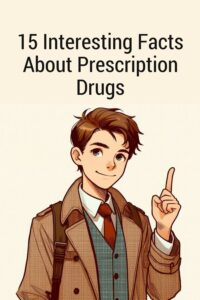Introduction:
Prescription drugs play a crucial role in modern healthcare, helping millions of people manage their conditions and improve their quality of life. While they are an essential part of medical treatment, there are many surprising and lesser-known facts about prescription drugs that may pique your interest. In this article, we will explore 15 intriguing facts about prescription drugs that may leave you amazed.
Fact 1: Placebo Effect
Did you know that even fake prescription drugs can sometimes have a positive effect on patients? This phenomenon is known as the placebo effect. When patients receive a placebo, which is typically an inactive substance such as a sugar pill, they may experience relief from their symptoms simply because they believe they are taking a real medication.
Fact 2: Expensive R&D
Developing a new prescription drug is a complex and expensive process. On average, it takes over a decade and costs billions of dollars to bring a single prescription drug to market. The high costs are primarily due to extensive research and development, clinical trials, and regulatory processes that ensure the drug’s safety and effectiveness.
Fact 3: Side Effects
Almost all prescription drugs come with potential side effects. These side effects can vary from mild, such as drowsiness or nausea, to severe, like allergic reactions or organ damage. Understanding and managing these potential side effects is an important aspect of healthcare professionals’ responsibility when prescribing medications.
Fact 4: The Generics Option
After a brand-name drug’s patent expires, other manufacturers can produce generic versions of the drug. Generic drugs contain the same active ingredients and are often more affordable than their brand-name counterparts. They undergo rigorous FDA testing to ensure their safety and effectiveness, providing cost-effective options for patients.
Fact 5: The Placebo Effect Reversed
Believe it or not, some patients might experience the opposite of the placebo effect – the nocebo effect. When patients expect negative side effects from a medication, they may actually experience them, even if they are taking an inactive substance. The power of the mind can be astonishing.
Fact 6: Antibiotic Resistance
Overuse and misuse of antibiotics have contributed to the rise of antibiotic resistance. This occurs when bacteria evolve and become tolerant to the drugs designed to kill them. Antibiotic resistance is a significant concern for public health, as it can lead to untreatable infections.
Fact 7: Off-Label Use
Sometimes, prescription drugs are prescribed for conditions other than those they were originally approved for. This practice is known as off-label use and is legal and common. Healthcare professionals may determine that a drug could benefit a patient’s condition even if it’s not officially indicated for that purpose.
Fact 8: Polypharmacy
Polypharmacy refers to the use of multiple prescription drugs simultaneously. While this can be necessary for some patients with multiple health conditions, it also increases the risk of drug interactions and side effects. It is essential for healthcare providers to carefully consider the potential implications of combining various medications.
Fact 9: Black Box Warnings
In some cases, prescription drugs receive Black Box Warnings from the FDA, the most severe type of warning in the labeling of prescription drugs. These warnings highlight serious or life-threatening risks associated with the medication. It is crucial for healthcare professionals and patients to be aware of these warnings and make informed decisions.
Fact 10: Prescription Drug Abuse
Prescription drugs, particularly opioids and benzodiazepines, have the potential for abuse. The misuse of prescription drugs can lead to addiction, overdose, and even death. It is crucial to educate patients on the risks associated with these medications and promote responsible use.
Fact 11: Drug Interactions
When multiple prescription drugs are taken simultaneously, the potential for drug interactions arises. Drug interactions can alter the effectiveness or safety of the medications involved. Healthcare professionals carefully consider these possibilities when prescribing medications, ensuring they avoid potentially harmful combinations.
Fact 12: Shortages and Supply Chain Issues
Occasionally, prescription drugs may experience shortages due to various factors, such as manufacturing problems or supply chain disruptions. These shortages can lead to difficulties in accessing necessary medications and often require healthcare professionals to explore alternative treatment options for their patients.
Fact 13: The Placebo Surgery Effect
In certain cases, even surgery can be subject to the placebo effect. Some studies have shown that patients who undergo placebo surgeries, where no actual procedure is performed, can experience significant improvements similar to those who receive the actual surgery. This highlights the power of perception and belief in healthcare outcomes.
Fact 14: Orphan Drugs
Orphan drugs are medications developed specifically to treat rare diseases that affect a small number of patients. Due to low market demand, these drugs may not be financially viable for pharmaceutical companies to develop, resulting in limited availability and potential higher costs.
Fact 15: Adherence Challenges
One common issue with prescription drugs is patient non-adherence, which refers to the failure to take medications as prescribed. Various factors contribute to this, including forgetfulness, cost concerns, and lack of understanding about the importance of medication adherence. Improving adherence is crucial for optimizing treatment outcomes.
Conclusion
Prescription drugs are not only powerful tools in managing health conditions but also fascinating when it comes to their various aspects. From the placebo effect and side effects to the challenges of compliance and drug interactions, the world of prescription drugs is filled with surprises. As we continue to advance in medical research and pharmacology, it becomes even more important to stay informed about prescription drugs and their impact on our well-being.
Subscribe to our email newsletter to get the latest posts delivered right to your email.



Comments